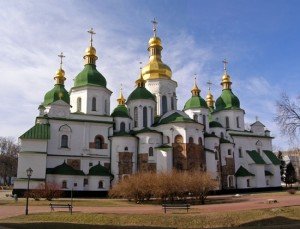The Rus’ state reached its zenith at the end of the 10th century and the first half of the 11th century. On the east lay the Volga Bulgars and the Patzinaks, who were decisively vanquished in 1036, some 48 years after Volodymyr the Great had all the citizens of his kingdom baptized.
Poland expanded under Boleslaw, taking territory from the Germans, the Magyars and Rus. In 1019 Boleslaw took the Cherven cities of Galicia. After his death in 1025, this area was retaken by Rus.
The Byzantines took the Crimea in 1016. In 1018 they destroyed Bulgaria, which had developed a rich Eastern Christian culture.
The Rus cities of Polotsk and Novgorod developed a degree of autonomy at this time. Novgorod was given its own charter after its prince, Yaroslav, moved his capital to Kiev in 1036. The city gained ecclesiastical autonomy.
For some time the Papacy had been suffering a decline in its temporal power. But around 1000 the Church recovered and began enjoying a new prosperity and prestige. At this time the relations between the Eastern and Western Churches also deteriorated. The Church in Rus and the Slavic lands was associated with the Eastern branch of the Church. The Great Schism of 1054 greatly influenced the history of the Greek faith in these territories.
Volodymyr strengthened his ties with Byzantium through his personal acceptance of the new faith and his marriage to the Emperor’s sister, Anna.
When Volodymyr died in 1015, civil war broke out. Svyatopolk battled Yaroslav of Novgorod. In the confusion, Poles took Kiev in 1018. In the following year, Yaroslav succeeded in taking the capital. Defeated by Mstyslav, Yaroslav retreated to his base at Novgorod. Seven years later he conquered the Cherven cities to the west. Polotsk went its own way.
For a dozen years, Rus was divided between Yaroslav and Mstyslav. But when Mstyslav died in 1036, Yaroslav became master of the realm. He then re-united Rus and settled in Kiev, setting the stage for a new era in the history of Rus.
Yaroslav’s state could not become fully Christian and Slavic. The canonization of Borys and Hlib round 1020 prepared the ground for a native Christian culture. Slavic translations of Greek texts were imported from Bulgaria, which Byzantium had destroyed as a state in 1018. The Church Slavonic language and alphabet, developed by SS Cyril and Methodius, was adopted.
Christianity grew in this milieu and attached the Christians in this area to the Greek expression of the faith which allowed for the influence of Slavic culture on the services of the church. This highlights the fact that the Byzantine faith is not expressed in an identical manner in all the countries where it exists.

